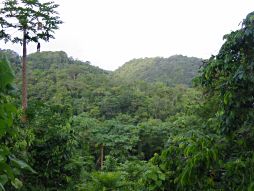Main content:
Keeping Forests Usable


Forests are relevant to climate, air quality and water balance, they are important because of their high biodiversity and bioproductivity, and, moreover, they are a direct source for food.
Affected people and foundations of life: About 4.6 billion people depend on forests for their water ( 2005, 29). Deforestation has risen the risk of malaria in Africa and South America by increasing the habitat suitable for mosquitoes that transmit malaria (MA 2005, 114).
The global area of forests has been halved over the past three centuries. In the nineties 12 million hectares of tropical rainforest were lost annually (in Africa 0.7% per year), while in temperate and boreal zones, forest cover expanded by 3 million hectares per year, especially by plantations. (MA 2005, 29, 33.) Between 18% and 25% of greenhouse gas emissions each year originate in deforestation. Half of deforestation (6 million hectares a year) takes place in primary forests, which make up 36% of the world's forests. ( 2007, 23.) Most of the logging in the tropical and boreal regions involves "cut-and-go" operations, without caring for the long-term regeneration of the forest. In the tropics, most logging is followed by subsequent transition to other land uses, such as crop production and livestock grazing. ( 2008, 205.) Each year illegal logging in public lands alone causes estimated losses in assets and revenue in excess of 10 billion, and losses to governments because of evaded taxes and royalties on legally sanctioned logging of US$ 5 billion. Moreover, revenues from illegal logging fund national and regional conflicts, and opportunities for money laundering are provided. ( 2006, 1)
Targets/goals: to reverse the loss of forest cover worldwide by sustainable forest management (target of 2006, 3).
Trend: + The annual net loss of forests has reduced from 8.9 million hectares in the 1990s to 7.3 million hectares in 2000-2005 (equivalent to the area of Panama; UN 2008, 38, and 2006, 16f.). A decrease by 13% of global forest area is projected from 2005 to 2030 (OECD 2008, 205). To reach the target of UNFF, net loss has to be reduced to zero.
Measures: Sustainable forestry is to be extended (UN Declaration on Forest Principles 1992): setting standards for intensity and species of logging; the obligatory implementation of environmental impact assessments; fees or charges for logging and trading; taxation on the conversion of forest land to other uses; subsidies for afforestation; removal or reform of existing subsidies for logging or establishing plantation forests or agricultural fields on natural forest land; and eco-certification (OECD 2008, 206). Trading of illegally felled timber has to be supervised and restricted. The World Bank finances more than US$ 300 million in forest law enforcement and governance activities (WB 2006, 2). Poverty reduction, soil protection, and access to modern energy can open up alternatives to depletion. Recycling of paper can be expanded, and wasting of paper reduced.
Annotations: For numeric names the short scale is used:
1 billion = one thousand million = 109 = 1 000 000 000
Sources
- MA 2005 – Millennium Assessment: Ecosystems and Human Well-being; Synthesis; A Report of the Millennium Ecosystem Assessment.
 (Written on behalf of the UN, coordinated by UNEP.) Washington.
(Written on behalf of the UN, coordinated by UNEP.) Washington. - OECD 2008 – Organisation for Economic Co-operation and Development: OECD Environmental Outlook to 2030. Paris, 2008. ISBN 978-92-64-04048-9. Summary in English.


- UN 2006 – United Nations: The Millennium Development Goals Report 2006. New York, 2006.

 [Published by the United Nations Department of Economic and Social Affairs DESA – June 2006.]
[Published by the United Nations Department of Economic and Social Affairs DESA – June 2006.] - UN 2007 – United Nations: The Millennium Development Goals Report 2007.

 [Published by the United Nations Department of Economic and Social Affairs DESA – June 2007.]
[Published by the United Nations Department of Economic and Social Affairs DESA – June 2007.] - UN 2008 – United Nations: The Millennium Development Goals Report 2008.

 [Published by the United Nations Department of Economic and Social Affairs DESA – August 2008.]
[Published by the United Nations Department of Economic and Social Affairs DESA – August 2008.] - UNFF 2006 – United Nations Forum on Forests: Report of the sixth session.


- WB 2006 – World Bank (The International Bank for Reconstruction and Development): Strengthening Forest Law Enforcement and Governance; Addressing a Systemic Constraint to Sustainable Development.

 (Report No. 36638-GLB) Washington, August 2006.
(Report No. 36638-GLB) Washington, August 2006.
Draft (2008)
This draft is to be reviewed by experts. Your hints are welcome, please use the contact form.
Photo credit: © David Anderson, Centre College
